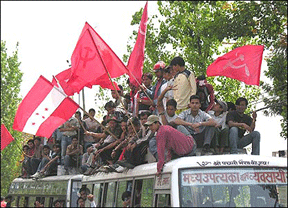 People's Democracy
People's Democracy
(Weekly
Organ of the Communist Party of India (Marxist)
No. 18
April 30, 2006
(Weekly
Organ of the Communist Party of India (Marxist)
|
Vol.
XXX
No. 18 April 30, 2006 |

CELEBRATION TIME: People celebrating their victory on the streets of Kathmandu
THE
24th of April 2006 will go down as a historic day in Nepal. It is on this date
that King Gyanendra backed down in the face of a massive popular movement and
announced the reinstatement of the dissolved parliament. Since the call for a
general strike on April 6 by the seven party alliance, for nineteen days the
people belonging to all sections of society poured out into the streets. Defying
brutal repression by the police and the armed forces, curfew and the
shoot-at-sight orders, the people of Nepal waged a heroic struggle against the
autocracy. Fourteen people, most of them young men, died in the brutal police
firings and lathi-charges and 5,000 more were injured. Yet, there was no
stopping the mass upsurge which spread to every part of Nepal.
The
militant popular movement soon became a rebellion against the despotic King with
the demand that the monarchy be ended. It is due to the people's upsurge that
this victory was achieved. The first stage of the struggle against the autocracy
and for the institution of a democratic republic has been successfully
completed. The 12-point agreement arrived at between the seven-party alliance
and the Maoists paved the way for the broadening of the popular movement for
democracy and isolating the King who launched a coup 14 months ago.
The
seven-party alliance has decided to form a government with Girija Prasad Koirala
as the prime minister. The King in his proclamation announced that parliament
would meet on April 28. The seven-party alliance has declared that the
parliament will immediately decide on the holding of elections for the
Constituent Assembly. This is a key demand which is part of the 12-point
agreement between the seven parties and the Communist Party of Nepal (Maoist).
The Maoists have rejected the King’s proclamation as a ploy to save his
autocratic monarchy. The Maoists were not for reviving the old parliament.
Instead, they were for an interim government formed after a political conference
of all concerned parties and forces which can call for the Constituent Assembly
elections. This problem can be overcome when the revived parliament takes up the
setting up of a Constituent Assembly as the topmost agenda.
Madhav
Kumar Nepal, the general secretary of the CPN(UML), which is an important
constituent of the seven-party alliance, has announced that the new government
would remove the characterisation of the Maoists as “terrorists”, declare a
ceasefire, involve the Maoists in a dialogue and go for a Constituent Assembly.
This approach provides the way for both sides – the new government and the
Maoists – to go ahead and implement the 12-point agreement. The Maoists taking
note of the prime minister designate’s statement that the Constituent Assembly
will be the main agenda of parliament has announced the suspension of the
blockade of Kathmandu and other towns till the parliament meets and takes a
decision.
The
first stage in the democratic transformation has to be consolidated by ensuring
that the Maoists are brought into the political process so that there is an
agreement on the next step towards a Constituent Assembly. The King will try his
utmost in the coming days to retain as much power as possible including crucial
control over the army. The United States has repeatedly emphasised the necessity
for an understanding between the King and the seven parties excluding the
Maoists. The US ambassador had denounced the 12-point agreement between the
seven parties and the Maoists. The US will make all efforts to shore up the
King.
The
BJP has been taken aback by the popular upsurge against the monarchy. After
having lauded for long the monarchy of a “Hindu Kingdom”, the BJP finds the
popular hatred for the King unpalatable. L K Advani has charged that the CPI(M)
is trying to bring the Maoists into the political process which is against
India’s security interests. Advani and the BJP are not in the least concerned
about the people of Nepal and their democratic rights. The CPI(M) has welcomed
the decision of the Maoist party in Nepal to participate in a multi-party
democracy under the republican constitution. This provides the basis for a
genuine democratic transformation in Nepal. The BJP, not surprisingly, has lined
up with the United States against the democratic wishes of the Nepalese people.